| Author |
Topic |
|
|
maryjane
    
7076 Posts
|
 Posted - Feb 13 2018 : 10:21:06 AM Posted - Feb 13 2018 : 10:21:06 AM


|
I shot three videos of Julie milking Anna and thought I'd share.
Anna getting groomed.
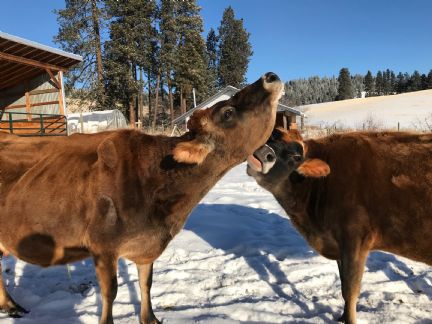
Anna and her heifer calf, Maybelle, born May 2, 2017.
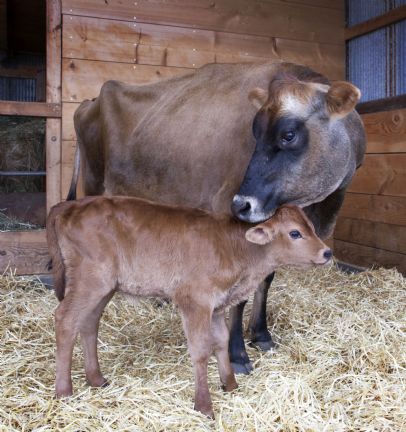
Anna and her cohorts taking a midday nap (she's on the left).
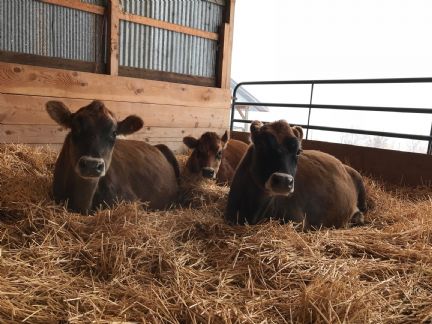
And my granddaughter testing milk before milking. Anna is a gentle soul and perfect for kids to learn on.
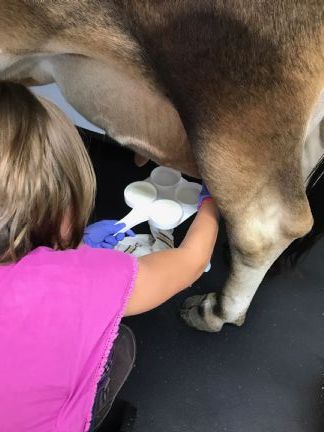
And the gorgeous Anna herself posing for her HJO registration certificate.

I love it that she comes running to her name.
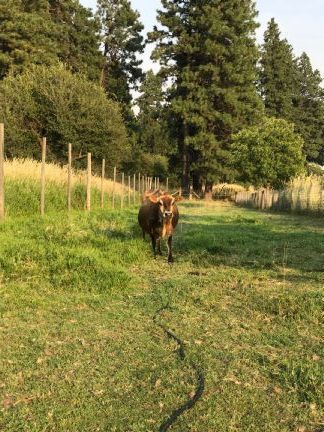
Under my care, Anna hasn’t always been as healthy and robust as she is now. I thought bringing home a classic, high production, standard-sized cow from the CovingtonJerseys.com dairy in Iowa would be a good idea—one cow to give me 5 or more gallons/day, but what I didn’t know is that I also needed to be schooled first in the care a cow like her.
Soon after she calved, she came down with loose, explosive diarrhea. If I knew then, what I know now (thank you for your patience, Anna), I could have saved us both a lot of anguish. I’d been putting my cows out on spring pasture for increasing amounts every day, but the grass wasn’t high yet and it couldn’t really replace the amount of food she needed in her early stage of lactation. On the third day, here’s what happened while getting her cleaned up for milking (I was milking her 2x/day).
.jpg?v 43375936)
If only I’d known to check her ketones, https://www.heritagejersey.org/chatroom/topic.asp?TOPIC_ID=26012, none of what follows would have happened.
What they say about the importance of feed and rumen microflora and fermentation is even more critical in a high-production cow because they’ve been bred to put most of their energy into milk production. In a cow like Anna, her diarrhea meant she should have been put on watch and her ketones checked because once they go into a state of ketosis, their brains become starved for the glucose that is needed to trigger the urge to eat. So, within a few more days, I noticed Anna wasn’t eating very well, if at all. Once she started to look too skinny (still giving copious amounts of milk to us and her calf), I rushed her to the WSU Vet School just 11 days after she’d calved. Here’s a post/photos about that: https://heritagejersey.org/chatroom/topic.asp?whichpage=1&TOPIC_ID=24972#53625
They sent her home the next day after giving her a dose of phosphorous/calcium and a dose of rumen juices from a donor cow, but she continued to lose weight. I took her back to WSU 4 days later and wrote an email to Tim Covington, the man who sold her to me. Here’s a post/photos about that: https://heritagejersey.org/chatroom/topic.asp?whichpage=1&TOPIC_ID=25977#54650. WSU wasn’t up to speed on the latest for how to deal with ketosis. They gave her an IV (propylene glycol) and had me leave her there for observation. Here’s a post on that: https://heritagejersey.org/chatroom/topic.asp?TOPIC_ID=25979
So, when the Reashure (http://anh.balchem.com/node/67) arrived (that her previous owner recommended), I took some of it to her at WSU the minute it arrived, Saturday delivery. We gave her some and saw an improvement, so I brought her home. They told me I should stop milking her twice/day and cut her back to once immediately, which I did. They also thought I should stop feeding her alfalfa silage (Chaffhaye) and sent me home with a bale of alfalfa hay and told me to supplement with plenty of grain. She wasn’t very interested in the alfalfa (I found a source for more bales), but she would eat my grass hay (not high enough in protein for a lactating cow) along with some Purina cattle chow designed for “lactating cows in confinement.” The grain I give my girls (in small amounts) is organic but she wasn’t interested in it. If she would eat the Purina w/molasses (sold at our local feed store), fine with me. I kept trying to put weight on her and was somewhat successful throughout the month of June, but she was eating too much grain as it turns out because one evening I noticed she was starting to bloat.
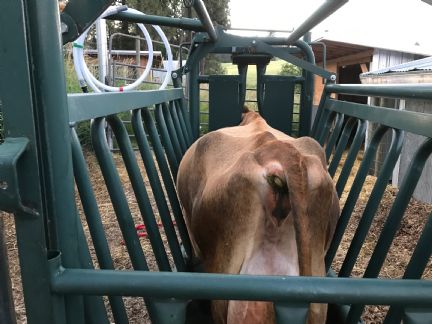
Connie and I tubed her for close to two hours because the hose kept clogging (the foam in her stomach was too dense and thick). In and out with the hose, over, and over again (poor Anna). By the time the vet arrived close to midnight on the 4th of July, she’d collapsed in the squeeze chute, her swollen rumen choking her lungs and heart. He inserted a trocar to give her relief. After watching him do it, I feel confident I'd be able to do it myself if I ever had to. (Anna's new red bling--that saved her life, stayed with her for a while and it was super easy to remove when the time came and left no scarring at all.)
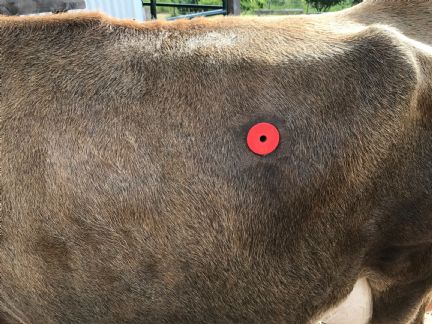
He also gave her an IV of calcium. He said she was very low in calcium (lack of calcium abundant in alfalfa/Chaffhaye).
Here’s something he told me: a cow’s nose should always, even in the dead of winter, have tiny sweat beads on it. If not, she’s low in calcium. Anna didn't have any sweat beads at all.
We opened the side of the chute and rolled her out. She was too weak to stand until we brought her calf to her, but that got her up.
The next day, I emailed her previous owner again to ask him what feed he had raised her on. I’d mistakenly assumed a large dairy like his fed their cows a diet high in grain (some sort of high-protein composite feed) to help with milk production. As it turns out, she was raised on corn silage that his family grows (and ferments) along with grass hay and pasture. He doesn’t feed much grain at all, only during milking. If I’d brought her home from WSU and put her back on Chaffhaye and grass hay, she wouldn’t have bloated. I immediately started feeding her Chaffhaye again (good also for providing calcium) and grass hay and only one small scoop of grain during milking (mixed with Chaffhaye).
Since then, I’ve checked her ketones regularly, even when she has a rapturous appetite, just to be sure. The minute I see any trace of ketones, she gets Reashure (one coffee scoop mixed in with her Chaffhaye--only costs a few pennies). For the most part, she’s received the dose suggested for pre and post calving, even though she’s several months out from that. It’s a super easy fix and if I’d put her on it before and after she’d calved, none of this would have happened (as it turns out she was given Reashure for all of her prior pregnancies--21 days prior and 21 days post). Reashure is granulated choline supplement that's been protected from rumen degradation through encapsulation (enables it to survive the juices in the rumen). Choline is a nutrient that’s essential for the health of animals and humans because it’s a biochemical building block. In dairy cattle, choline is required to help the liver process and metabolize fat. If cows are deficient in choline, fat cannot be transported out of the liver and instead, it’s stored there. Because the liver has limited ability to store fat, it is diverted toward the production of ketones which enter the blood stream and may elevate to the point of toxicity (ketosis), causing reduced feed intake and eventually a reduction in milk yield. Given to a cow prior to delivery, choline helps also with ease of delivery and can help make a calf more robust upon birth.
The lesson here? Don't be reluctant to ask about the entire life history of a cow when you bring one home. I’ve sold a few cows over the years and have always provided their vet records. However, when I talk to people who call about the cows I have up for adoption, I’ve noticed a tendency toward them feeling overwhelmed if I offer too much information. I mean, wouldn’t it be easier to simply make a phone call, find a perfect cow, bring it home, and all is well forever more? Unfortunately, it doesn’t work like that. Adopting a cow is a lot like adopting a human child. There will be challenges. Learning (and also sharing) all you can about the specifics of a particular cow should be a privilege on both sides of the aisle. Learning about cow care and parenting the cow member of your family goes hand in hand with all the wondrous love, companionship, and food a cow so generously provides.
While Anna was recuperating, my grandgirls and Connie and Julie pampered her with routine, warm-water, full-body baths (while wearing spa gloves!). Anna is such a sweetheart and her personality is perfect for children. Without a doubt, Anna upped my game when it comes to vet care.
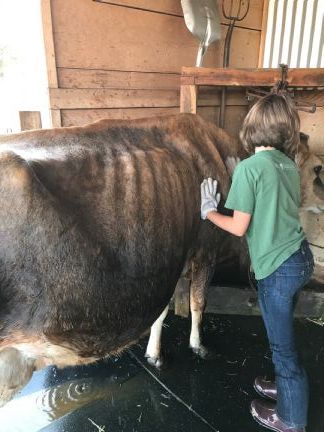
Update: It's been five days since I wrote the above and from my office window (morning milking is done), I just watched Anna bust loose and run/hip swivel kick like a calf, around and around the parlor, down to the end of the pasture and back several times. The other cows were looking at her like, "it's seriously winter, girlfriend, no, we don't want to run and jump through the deep snow." It's good to see her so happy and healthy, giving milk, and pregnant again, due 9/19/18. |
MaryJane Butters, author of Milk Cow Kitchen ~ striving for the stoicism of a cow standing in the rain ~ |
|
|
NellieBelle
    
11220 Posts
|
 Posted - Feb 16 2018 : 07:31:31 AM Posted - Feb 16 2018 : 07:31:31 AM


|
| Great videos and pictures of Anna, and Julie and Stella milking her. Such a sweet face. Nice to look back and now, here we are almost a year later, ready to go again. Like your set up of the EZ Milker tubing on a hook on your side rail to keep it up off the floor. |
To laugh is human but to moo is bovine. Author Unknown |
 |
|
|
maryjane
    
7076 Posts
|
 Posted - Mar 18 2018 : 08:26:44 AM Posted - Mar 18 2018 : 08:26:44 AM


|
I am pleased to report that Anna has found herself a new home. Can love happen over the Internet? Apparently so. There's a family not far from here who wants to bring Anna into their lives and continue her good care so she can give them her good milk. But because they'll be milking her by hand, I thought I better try that first to see how she does because I doubt she's ever been milked by hand.
In the end, we got this much milk milking her by hand:
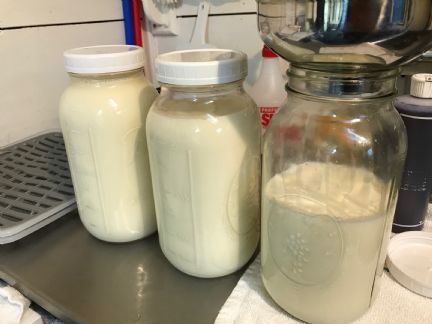
So we put the EZ on and finished the job that way, not because Anna got impatient, but because we did. It takes a while to get your hands in shape for milking. I used to milk by hand many years ago and could do it again if need be, but I love my EZ! Earlier this year, my girls were milked with my NuPulse every day, until I remembered how much I don't like cleaning it or listening to it (noisy!).

She's been giving us a couple of gallons a day OAD when milked with the EZ start to finish.
She was an angel and stood silently and without moving the entire time. I thought that maybe once she was done with her food, she'd object, but she didn't. What a sweetheart!
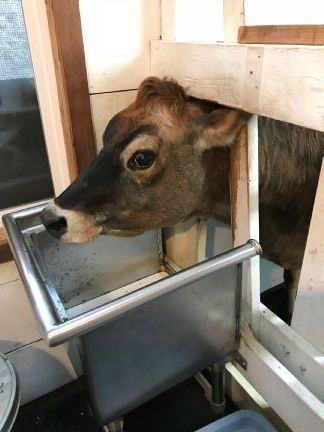
I also thought that with her standing there so long we should keep our poop catcher handy, but we didn't need it. When a cow tells us she's about to cut loose by shifting her feet apart and then arching her back, we hold the yellow "dustpan" up under her tail and catch her "garden gold" that way.
.jpg?v 36956255)
First, we washed her off outside (my girls love the new hot water install I did this past summer).
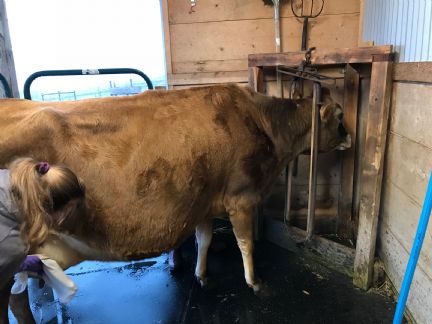
Like all my cows, she prances into my milking parlor, no questions asked.
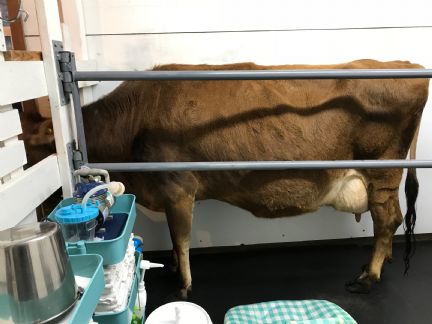
Her tail gets tied up for sanitation purposes.
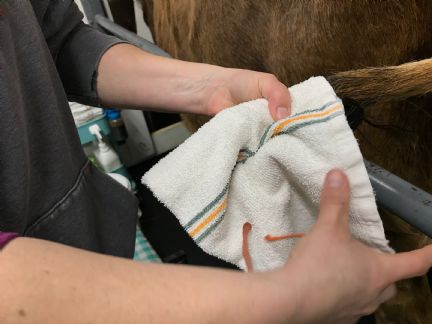
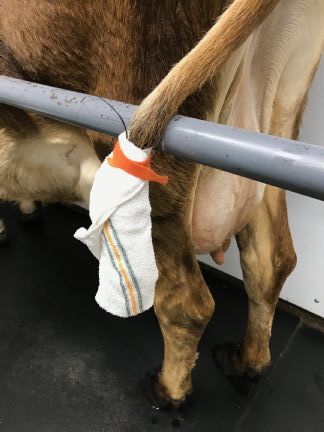
We strip her and do a California Mastitis test.
.jpg?v 15105594)
After that we dip each teat in iodine and let it sit for 90 seconds. (What looks like specks of dirt on her teats/udder is discolored skin pigmentation.) Using four different paper towels, we wipe the iodine off each teat. And then we clean each teat one final time with a separate disinfecting teat wipe.
Getting started milking Anna by hand:
Discovering that milking her back two teats was easier from behind:
Deciding that extra hands are even better (sweet Anna never said a word):
And then finishing up with the EZ:
|
MaryJane Butters, author of Milk Cow Kitchen ~ striving for the stoicism of a cow standing in the rain ~ |
 |
|
|
NellieBelle
    
11220 Posts
|
 Posted - Mar 19 2018 : 11:05:14 AM Posted - Mar 19 2018 : 11:05:14 AM


|
| Congratulations to both you MaryJane, and the new owners! |
To laugh is human but to moo is bovine. Author Unknown |
 |
|
|
maryjane
    
7076 Posts
|
 Posted - Mar 20 2018 : 10:16:29 AM Posted - Mar 20 2018 : 10:16:29 AM


|
We loaded Anna into our trailer this morning right after milking her for the last time. The drive from here to her new Idaho home is about 3 hours. She got lots of extra treats this morning and her udder got a bit of a haircut/touch-up and her tail was brushed.
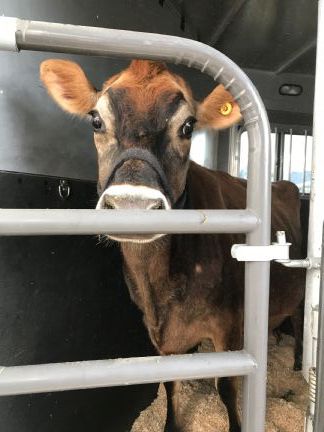
Now I can turn my full attention to the two calves I have coming and the two heifers I'm training, one of them Anna's daughter. I spent last night with Maggie. She isn't due until next Monday, but I've started "calf-watch" throughout the night already because this is her first calf. Maggie is a half sister to Miss Daisy. One of my farmhands drove to Wisconsin during a winter storm to bring her here when she was only a few months old. Once I had her here, I continued to bottle-feed her with milk from my cows. I'm excited to see how she does in the parlor. And Miss Daisy is due April 8. Last time she came two weeks early but I'm not seeing that this time. She's not looking close at all.
|
MaryJane Butters, author of Milk Cow Kitchen ~ striving for the stoicism of a cow standing in the rain ~ |
 |
|
|
NellieBelle
    
11220 Posts
|
 Posted - Mar 20 2018 : 3:23:52 PM Posted - Mar 20 2018 : 3:23:52 PM


|
| Much has transpired there in the last month. And much on the way as well. Anna looks so pretty, all groomed and ready to meet her new owners. |
To laugh is human but to moo is bovine. Author Unknown |
 |
|
| |
Topic |
|
|
|
![[flourish]](/images/flourish-txt_mobius.png)
![[flourish]](/images/flourish-txt_mobius.png)